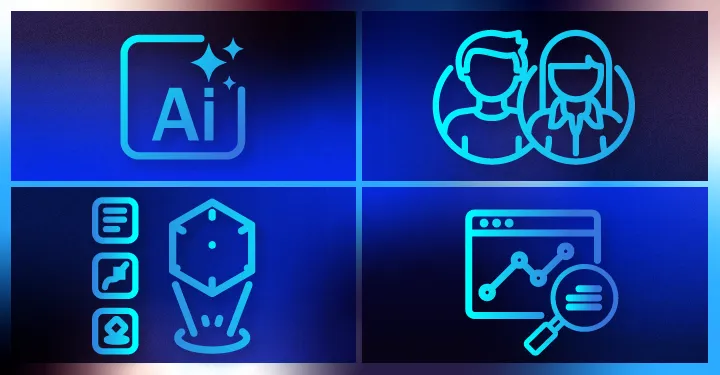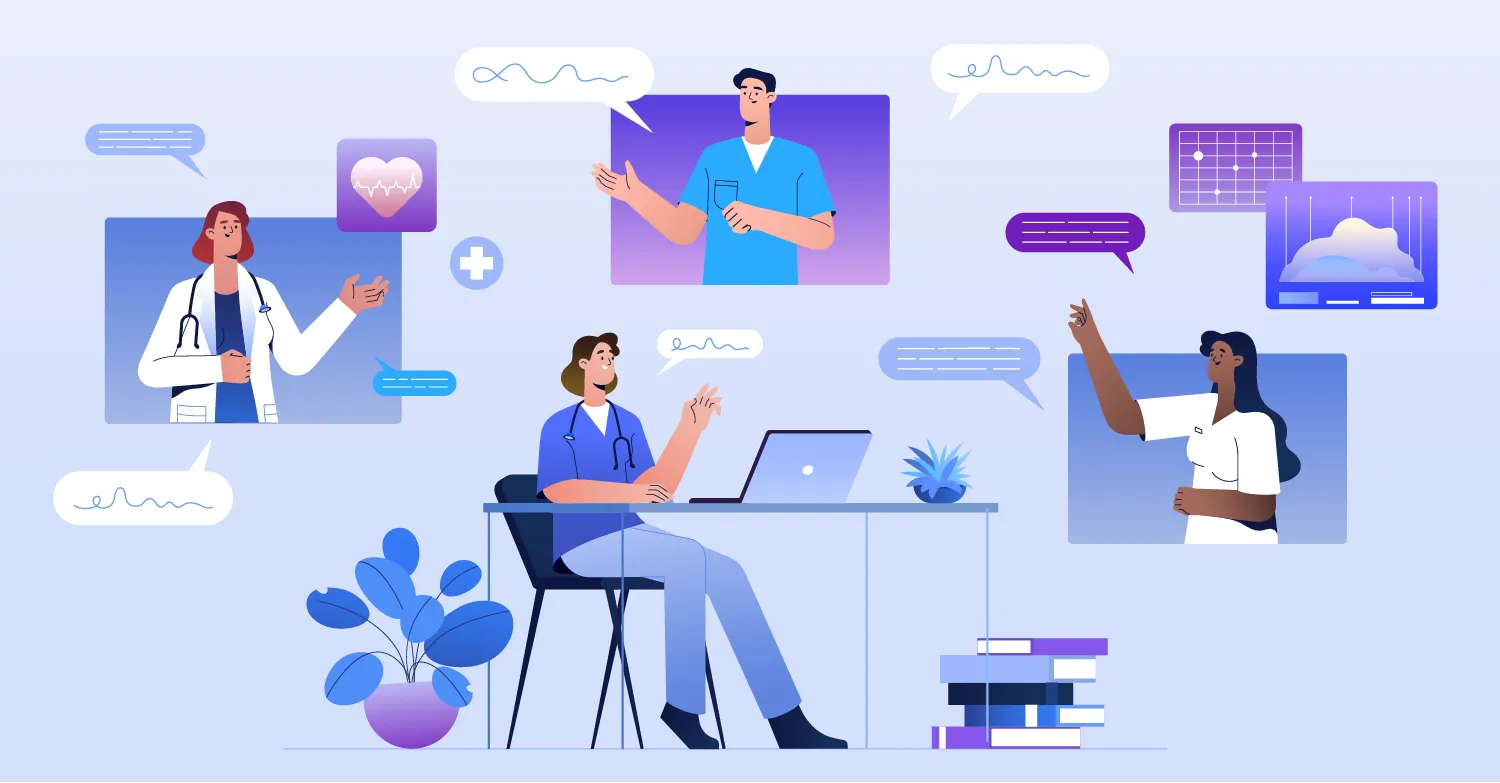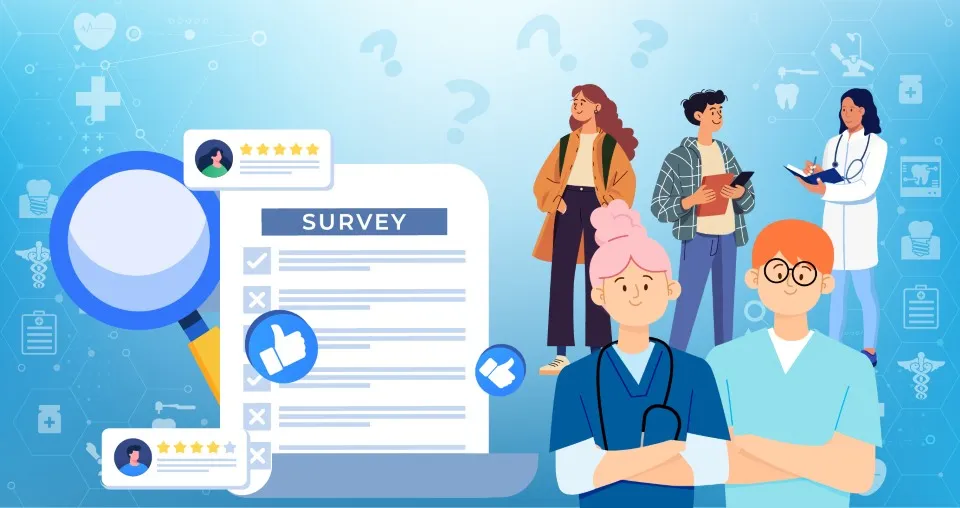5 Dental Education Statistics for 2025 That Highlight the Need for Immersive Learning Technology
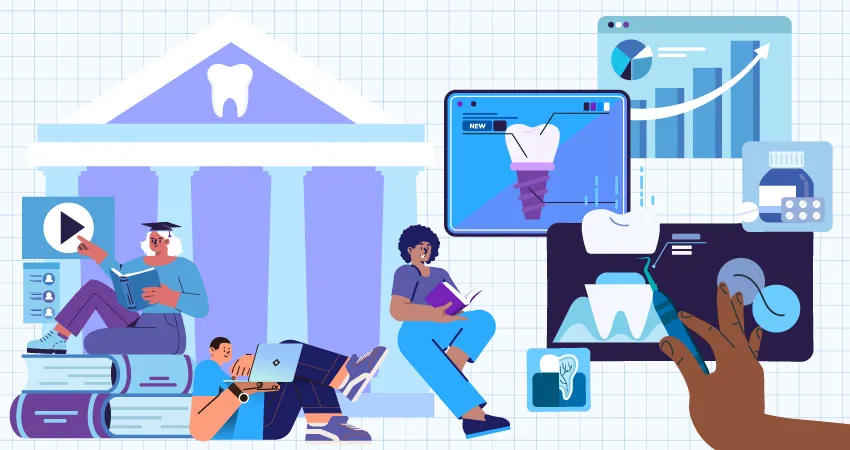
Today’s dental learners are largely digital natives looking for immersive training solutions and learning platforms.
That means (as a 2025 article in the Journal of Dental Education points out) cohorts are entering dental programs with 'unique expectations' that don’t always align with traditional teaching approaches.
According to the authors, this disconnect can cause suboptimal learning outcomes. Which, for institutions, might translate to:
- Lower graduate readiness
- Weaker student satisfaction
- Reputational risks
This doesn’t mean EdTech is a silver bullet capable of shattering every barrier students face: faculty support and curriculum design remain critical. But commentary like this is a valuable reminder that it’s essential to bring institutional priorities and educational practices into alignment with student needs.
That’s the driving force behind The Modern Dental Student 2025: Immersify’s landmark white paper drawn from a survey of 348 students and built to uncover what today’s learners truly need.
Read on to discover five of the most significant data points that the report unearthed, and walk away armed with a practical understanding of student preferences, the challenges they face, and how to bridge the gap between learner needs and institutional provision.
1) 91% of Dental Students Say Immersive Learning Technology Improves Knowledge Retention
This might not be one of the more surprising findings in The Modern Dental Student 2025, but that doesn’t make it any less significant.
When 91% of students agree or strongly agree that learning technology helps them retain and apply knowledge, there’s no room for institutional doubt: today’s dental curricula need to come equipped with a strong digital element.
It’s also worth noting that this question isn’t necessarily about preference or enjoyment, but efficacy. Our respondents are saying that learning technology is a good path toward knowledge retention, which is a fundamental goal of any educational program in dentistry and beyond.
The rest of the survey gave several indications of the pressures students face:
- High content volume
- Stress
- Time scarcity
While these are important findings in their own right, they also highlight the veracity of this appetite for learning technology. Dental students simply don’t have the time to waste on ineffective study methods. In that light, we can assume that they wouldn’t gravitate toward a tech-first approach unless, fundamentally, it worked.
But while there’s an overwhelming majority at play here, positive sentiment toward learning technology in general can only take institutions so far. The question quickly becomes: what kind?
MORE ON THE EFFICACY OF DIGITAL LEARNING | ‘Does Digital Simulation-Based Learning Actually Work? What the Evidence Says For Healthcare Education’
2) 85% of Students Want Their Institution to Use More Interactive Learning Technology
This is another clear majority, and it comes with two important takeaways for institutional leaders and educators.
Firstly, it points to a huge opportunity. More than eight out of ten students don’t feel their places of learning are making enough use of modern, interactive technology. That’s a clarion call for decision makers looking to stay competitive and ensure that their programs are:
- Meeting the expectations of incoming digitally native cohorts
- Bolstering graduate readiness to showcase institutional capabilities
- Conveying value for money amid rising tuition costs and lower public confidence in higher education
At the same time, this figure also contributes to a picture of the kind of learning technology students want. Interactivity is a key theme across the survey and echoes the previous answer, which points to learning technology as a means of helping students apply their learning (rather than solely retaining it).
What this suggests is a need for immersive training solutions: resources that help students do as well as understand. To dental learners, digital platforms are the scaffolding that help them reach higher levels of Bloom’s taxonomic pyramid, allowing them to move from understanding to application.
So, why does interactivity and application matter to today’s dental students? The next statistic sheds light on exactly that.
SEE INTERACTIVE LEARNING IN ACTION | ‘Simulation Spotlight: A Dental Charting and Examination Procedures Q&A’
3) 1 in 3 Dental Students Call for More Hands-On Clinical Skills Practice
Over a third of students, when asked to describe the one factor that would improve their learning experience, point to the need for more exposure to practical skills. That’s a signal that current curricula risk falling short in this essential area.
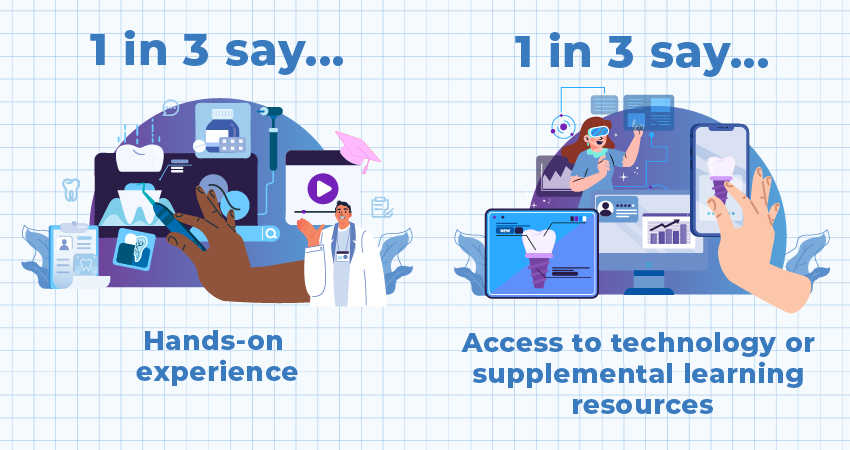 Coupled with this is the fact that the question took on an open response format, meaning every respondent could input any answer they liked. The implication here is that hands-on skills practice is a common preoccupation: students instinctively reach for it even when they’re at liberty to choose any issue they like.
Coupled with this is the fact that the question took on an open response format, meaning every respondent could input any answer they liked. The implication here is that hands-on skills practice is a common preoccupation: students instinctively reach for it even when they’re at liberty to choose any issue they like.
In some ways, this won’t be a surprise for educators. Labs, patients, and supervising clinicians are all finite resources, inherently limited by:
- Time
- Space
- Availability
But when this appetite for hands-on skills practice is viewed in the context of our wider findings, students clearly recognize how these limitations can be addressed: it’s all in the learning technology.
HANDS-ON SKILLS PRACTICE IS AN INTERDISCIPLINARY ISSUE. READ MORE | ‘Why Nursing Rotations Are Under Pressure (And How to Protect Student Readiness)’
4) 58% of Students Choose Digital Tools Over Textbooks for Dental Education
The Modern Dental Student 2025 is packed with insight on the types of immersive learning technologies students use (and, just as crucially, the types they want their institutions to supply).
A total of 58% of students named digital resources as study tools they rely on, including:
- AI tools
- Video tutorials
- Interactive platforms
- Flashcard apps
These are the resources students are using, and the survey went on to ask about the technologies they’d have benefitted from by way of pre-program preparation. In their open text responses to that question, one in three included at least one of the following:
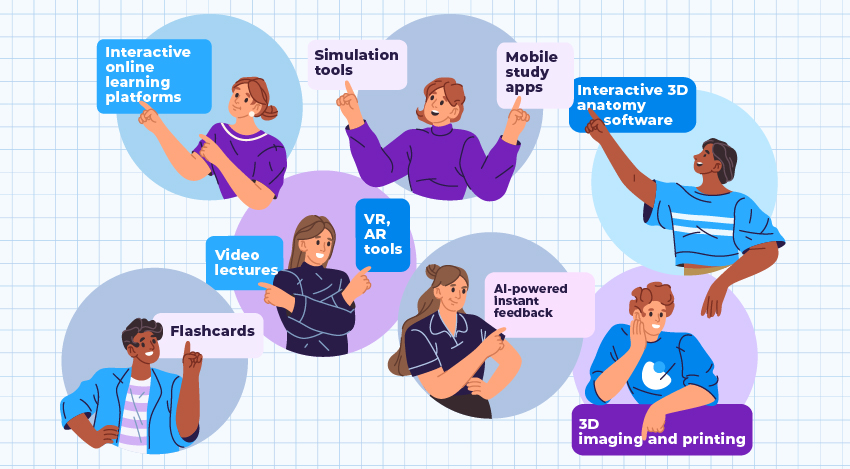 Institutional leaders will notice that immersive elements are threaded throughout these responses: students name interactive platforms and 3D anatomy software; simulation tools and virtual or augmented reality also make an appearance.
Institutional leaders will notice that immersive elements are threaded throughout these responses: students name interactive platforms and 3D anatomy software; simulation tools and virtual or augmented reality also make an appearance.
Crucially, these answers speak directly to the pain points students are experiencing in their studies. Difficulties in securing the time and space for hands-on skills practice might be seen as inevitable, but students are already asking for, and gravitating toward, the immersive resources that allow them to bridge that theory-practice gap.
TECH-ENHANCED LEARNING HELPS PROGRAMS SCALE. HERE’S WHY THAT MATTERS IN AN AGE OF WORKFORCE SHORTAGES | ‘How the Dental Hygienist Shortage Impacts Education and Access’
5) 81% of Students Support Pre-Dental Bootcamps and Supplemental Preparation
This statistic is well worth bringing onto institutional radars, if only because it points to a significant strength of feeling: after all, students are willing to give up their summers in the name of prematriculation!
But, at heart, this appetite for pre-program preparation is another way students are challenging assumptions about whether the accepted demands of dental education are truly unavoidable.
Students recognize the sheer volume and complexity of dental program content. Bootcamp initiatives are a legitimate means of tackling this head-on, priming students for success by introducing them to key concepts ahead of time.
And, as with other responses, all roads lead back to immersive learning technology. Not only is this a means of breaking content down digestibly (hence students’ interest in video lessons and flashcards), but it can also be used to easily distribute learning content at faculties’ convenience (whether that be over the summer or, indeed, prior to classes in a flipped classroom format).
That’s a key theme of The Modern Dental Student 2025, which uncovers a student body that’s not only aware of the challenges it faces, but that’s actively pointing to the solutions institutions can provide.
DISCOVER THE ADVANTAGES OF DELIVERING CONTENT BEFORE CLASS | ‘5 Benefits of Flipped Classrooms for Universities and Colleges’
Immersive Learning Factsheet
Immersive learning technologies include a range of digital platforms designed to replicate or extend real-world learning experiences. Examples include:
- Augmented reality (AR): Digital overlays on physical settings, such as anatomy models or patient simulations.
- 3D interactive platforms: Software that allows learners to manipulate and explore clinical scenarios in detail.
- Simulation-based learning activities: Digital simulations of procedures, materials, or patient interactions, often powered by manipulable 3D assets.
Together, these resources give students access to practical, skills-based learning without the all-too-common constraints of time, space, or resource availability.
Institutions and students benefit from immersive training in several ways:
- Enhanced retention and understanding: Visual, interactive content helps students remember complex concepts.
- Bridging theory and practice: Students can apply classroom knowledge in realistic scenarios before working with patients.
- Scalability: Digital resources can be used anytime, anywhere, supporting large cohorts without increasing faculty workload.
- Confidence and readiness: Repeated practice in digital environments helps students to fail safely and improve clinical preparedness.
A practical example of immersive learning in dental education might be a 3D simulation of local anesthesia administration. Students can explore nerve pathways, practice needle placement, and receive feedback in real time, all before attempting the procedure on a live patient. This blends safety with hands-on skill development, demonstrating how immersive training accelerates readiness.
While immersive learning brings clear benefits, institutions often weigh several considerations:
- Implementation costs: Hardware and software investment can feel significant. That's why mobile-first augmented reality platforms are so valuable, offering a friction-free way to introduce immersive learning technology without cumbersome hardware costs.
- Faculty adoption: Instructors can need support and training to integrate technology seamlessly. Platforms that support smartphone, tablet, and desktop use mitigate this concern by allowing educators to use immersive resources in the context they’re most comfortable with.
- Equity and access: Ensuring all students have equal opportunities to engage with immersive tools is essential. This was a subject addressed by the ADA’s Dr. Brett Kessler in a recent Immersify webinar, highlighting the value of using technology students already own in order to ensure equitable access.
- Curriculum alignment: The technology must be embedded into existing modules rather than added as an optional extra. This makes the service just as important as the platform: the right vendor will pre-align its content with existing curricula, ensuring curriculum-aligned integration without disruption.
TL;DR: 5 Dental Education Stats Around Immersive Learning Technologies for 2025
Immersify’s landmark survey, The Modern Dental Student 2025, revealed a range of institutional opportunities to meet rising student demand for EdTech, both as a preferred method of study and as a means of addressing even the most entrenched challenges in dental education:
- 91% of students agree or strongly agree that learning technology helps them retain and apply knowledge.
- 85% of students want their institution to make more use of interactive learning technology.
- One in three dental students want more hands-on clinical skills practice.
- 58% of students selected digital resources over textbooks when asked to choose a study resource they rely on.
- 81% of students support the idea of pre-program support in the form of bootcamps.
These findings paint a picture of students looking for immersive learning technology that can help them apply hands-on clinical skills, make high content volumes more digestible, and reflect the many learning modalities covered in the full report.
Ready for a Deep Dive Into the Minds of Today’s Dental Students?
For a full breakdown of our findings, download your copy of The Modern Dental Student 2025. The complete white paper includes wide-ranging analysis and actionable recommendations, and situates student concerns against an institutional backdrop of:
- Rising tuition costs
- Lower public confidence in higher education
- A greater need than ever to convey the value of dental education
This article was reviewed for educational relevance and clinical accuracy by Julia Tymoshenko, BDS.
Join our mailing list
Get the latest updates on immersive learning, industry trends, and resources delivered straight to your inbox.

